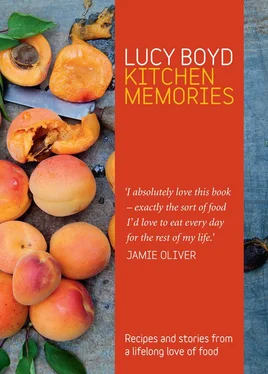There is a wonderfully pleasurable moment when you add the pounded spices to the fresh ginger and garlic in the hot oil – all the aromas are released and the whole kitchen fills with exotic smells.
20g fresh root ginger, peeled and chopped into small chunks
3 garlic cloves, peeled
¼ tsp ground turmeric
2 tsp coriander seeds
2 tsp cumin seeds
¼ tsp cayenne pepper
1 medium-sized chicken, jointed into its various parts (the butcher will do this for you)
3 tbsp olive oil
juice of 1½ lemons
1 fresh green chilli, stalk removed, then finely chopped (deseed if you prefer it less hot)
1 small bunch of fresh coriander, leaves picked from their stems, washed, dried and finely chopped
sea salt and black pepper
Put the ginger into the food processor with 2–3 tablespoons of water and blend to a paste.
Put the garlic, turmeric, coriander and cumin seeds and cayenne pepper into a pestle and mortar and pound together.
Season the chicken pieces well all over with salt and pepper
Heat a drizzle of the olive oil in a shallow, heavy-based pan, add the chicken pieces and brown them on all sides – it may be easier to brown them in batches if your pan is too small to fit them in without overlapping. Using a slotted spoon, transfer the chicken to a bowl.
Put the garlic and spice mixture into the still-hot pan (you may need to add a little more oil) and stir to release their flavours. Add the ginger and chopped chilli and stir-fry for a minute or so. Add the chicken pieces and any juices that have been released, then add 8 tablespoons of water and the lemon juice. Stir, then turn up the heat and bring to a boil, cover with a tight-fitting lid and turn the heat right down to a gentle simmer. Cook for 15 minutes until the chicken is tender and cooked through. Remove the lid and scatter the chopped coriander over. Serve with spiced basmati rice ( see here).
SPICED BASMATI RICE
FOR 4 (GENEROUSLY)
300g basmati rice
2 tbsp olive oil
1 small red onion, peeled and finely chopped
½ small fresh green chilli, cut in half lengthways, deseeded, stalk removed, then finely chopped
2 garlic cloves, peeled and finely chopped
500ml chicken stock
sea salt
1 tbsp cardamom pods, husks removed – leaving 1 tsp cardamom seeds
½ cinnamon stick
1 tsp black cumin seeds
2 whole cloves
¼ whole nutmeg, grated on the zest part of the grater
½ tsp whole black peppercorns
Grind all the ingredients for the garam masala together in a pestle and mortar or coffee grinder.
Put the rice in a colander or sieve and wash under cold water until the water runs clear. Put the rice in a large bowl, cover with cold water and leave to soak for minutes, then leave to drain for 20 minutes or so.
Heat the olive oil in a heavy-based pan over a medium heat, add the onion and fry gently until light golden in colour. Add the chilli and garlic and cook for a further 2–3 minutes. Add the garam masala and cook for a further minute or so, then add the rice and stir together well, so that the rice is coated with the spices and oil. Add just enough chicken stock to cover the rice and season with a little salt, then cover with a lid and bring to the boil. Turn the heat down and simmer over a very low heat for 5 minutes. Take off the heat and leave covered for 10 minutes – the steam will keep the rice nice and fluffy. Taste to check if the rice is ready – it should have a little bite.
GUINEA FOWL WITH PROSCIUTTO, MASCARPONE AND LEMON
Theo Randall, the head chef at the River Café for many wonderful years, taught me how, with just a few simple ingredients, to turn a dull breast of chicken into something more exciting to eat … a little lemon zest grated into creamy mascarpone with some finely chopped rosemary and then stuffed between the chicken’s flesh and skin, followed by – to add more flavour – a small slice from the end of the Parma ham (this is the bit where the flavour is intensified, where the fat is just as sweet as the meaty bits). I like to make it with guinea fowl, with its slightly gamey flavour.
150g mascarpone
1 sprig of fresh rosemary, leaves picked from their stems, washed, dried and finely chopped
1 small unwaxed lemon
4 guinea fowl breast supremes, skin on, or 4 chicken supremes with wing attached
4 slices of prosciutto
olive oil
a knob of butter
sea salt and black pepper
Preheat the oven to 210ºC (190ºC fan) Gas 6½ Put the mascarpone and chopped rosemary in a bowl. Grate the lemon on the zest part of the grater and add to the bowl. Season with salt and pepper and mix together.
Place each supreme on a board and push your fingers up between the skin and the flesh to make an opening. Reserve a generous spoonful of the mascarpone mixture for the sauce. Put a spoonful of the mixture between the skin and flesh, then insert a slice of prosciutto to lie flat against the skin (if the slice is too large, tear it in half). Season the breasts on the outside.
Use a small roasting tin or shallow, flameproof, ovenproof dish large enough to hold the supremes in one layer. Heat a drizzle of olive oil and the butter in the tin or dish and brown the breasts on both sides until golden. Place in the oven for 15 minutes until cooked. Transfer the breasts to a serving dish and keep warm. Add the reserved mascarpone to the hot pan with a squeeze of lemon – the mascarpone will melt and mingle with the lemon juice to make a delicious sauce to pour over the breasts. Serve straight away.

BROAD BEANS AND MINT
FOR 4
1kg broad beans in their pods
2 garlic cloves, peeled and crudely cut into slices
2–3 sprigs of fresh mint, washed and dried
extra-virgin olive oil
salt and black pepper
Bring a pan of water to a boil while you are podding the beans, then put the beans in. Cook for 3–4 minutes – the smaller and younger they are the less cooking is needed. Drain, then put in a bowl with the garlic and mint. Pour enough extra-virgin olive oil over to coat the beans, then season with salt and pepper. Let the hot beans take on the flavour of the garlicky, minty olive oil for 3 minutes or so, then remove the raw garlic pieces and the mint before serving.
Broad-leaved rocket is incredibly easy to grow as a cut-and-come-again salad leaf. It has a wonderful peppery flavour that goes so well with tomatoes, or if you need a leaf that ‘cuts’ into other flavours, or as an alternative to flat-leaf parsley. It is just so useful to have available on your windowsill or in the garden – you will always have some fresh green leaves to add to your meal without having to go and buy the commercially produced wild rocket, which tends to lack flavour.
Rocket will grow pretty much anywhere, in shade or sunlight. You can sprinkle a few seeds in pots that contain trees, shrubs or perennials, or on a bare patch of soil. It germinates in a few days and can be picked after a few weeks. The first growth is less peppery than the second, when the stems become thicker and the leaves a slightly darker green with a stronger flavour. March/April is a good time to sow seed – every twelve weeks or so will give a continuous crop. When the summer gets going the plants tend to bolt, producing small, delicate, white flowers, which can be used in salads. After this the plants will be too tired to produce anything more worth picking, by which time your new sowing will have got under way and should be ready for picking the first young leaves.
Читать дальше













